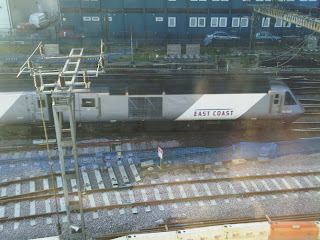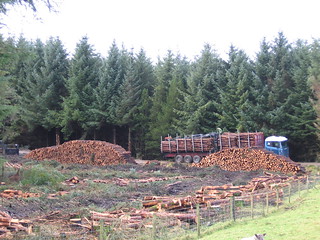It seems amazing that a year has passed since my report on the 2008 'Santa Specials' at Peak Rail. Once again, I had a couple of turns on the footplate. The format of four round trips during the day with a 7-coach train 'top-and-tailed' was retained. 'Royal Pioneer' was at the south end but, this year, the north end was graced by '8624', the only known maroon '8F' in captivity.
Sunday, 6th December
On Sunday, 6th December I was on 'Royal Pioneer'. 'Royal Pioneer' is still stabled at Darley Dale but, for the 'Santa Specials' this year, both 'Royal Pioneer' and the '8F' were prepared on the long outside pit at Rowsley. Fortunately, the weather wasn't bad for December but, of course, it does gets dark early.
Seven coaches plus the weight of the '8F' gave 'Royal Pioneer' a decent load but she's perfectly equal to the task - she'll move 1,000 tons on the flat, just not very quickly. Speed isn't a requirement for 'Santa Specials'. There are a lot of people moving around on the train - Santa, all his helpers, the entertainers - so smoothness is what's required. On this Sunday, 71 diners were being given Christmas Luncheon so that's another reason to avoid jerking. Steam heating of the train was being left to the '8F' so the fireman on 'Royal Pioneer' could concentrate on providing the steam to get from Rowsley to Matlock and then look forward to a rest whilst the '8F' took us back to Rowsley.
Temporary watering facilities had been provided for 'Royal Pioneer' at the south end of Rowsley. The arrangements comprised a tank wagon, provided with a small-capacity connection to the mains water supply to replenish the tank wagon, connected to a portable water pump powered by a petrol engine. A fire hose was normally stowed on the ballast parallel to the tracks which was dragged across to the tank filler of the adjacent locomotive as required.
Saturday, 12th December
On Saturday, 12th December I saw the 'other end' of the operation because I was on the '8F'. With outside Walschaerts motion, the '8F' is easy to oil round, apart from the necessity to attend to the axlebox underkeeps which requires the use of the pit (an earlier post describes preparation in a little more detail). Around 10.00 a.m., we came 'Off Shed', coupled onto the stock and started steam heating.
During the day, we made four round trips, with 'Royal Pioneer' hauling the train to Matlock and the '8F' returning the train to Rowsley. The '8F' performed flawlessly and it was, as usual, a pleasure to be on the footplate of a Stanier engine. Stanier, of course, was at Swindon for a number of years before being 'head-hunted' by the L.M.S. His designs added his own flair to the 'Wiltshire Wisdom' he brought with him from the G.W.R.
Apparently, the 2009 Santa trains produced a Santa revenue record for Peak Rail. This result is due to the hard work and dedication of lots of volunteers to whom thanks are due.
There are a few pictures here.














